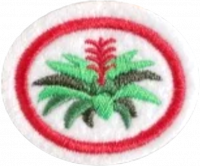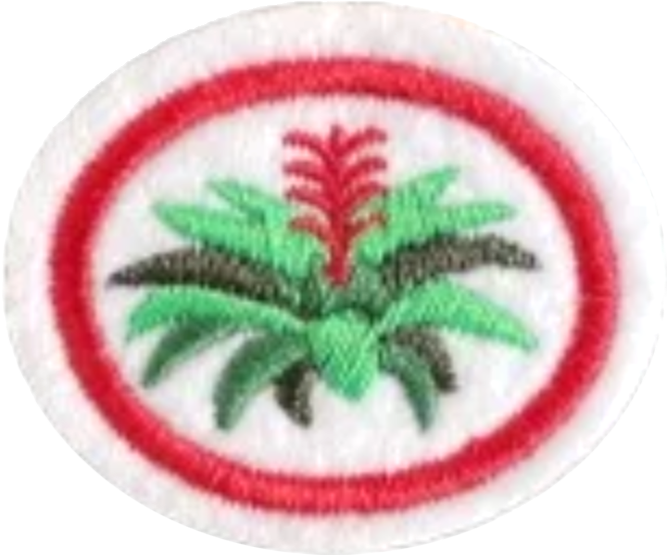Difference between revisions of "AY Honors/Bromeliads/Requirements"
(+ Reqs. for Bromeliads AY Honor (SAD)) |
(Marked this version for translation) |
||
| Line 2: | Line 2: | ||
<section begin=Body /> | <section begin=Body /> | ||
| − | <b>1. <section begin=req1 /><noinclude><translate></noinclude>What are the main characteristics of bromeliads? | + | <b>1. <section begin=req1 /><noinclude><translate><!--T:1--> |
| + | </noinclude>What are the main characteristics of bromeliads? | ||
<noinclude></translate></noinclude><section end=req1 /></b> | <noinclude></translate></noinclude><section end=req1 /></b> | ||
| − | <b>2. <section begin=req2 /><noinclude><translate></noinclude>Why were bromeliads given this name and what were they called? | + | <b>2. <section begin=req2 /><noinclude><translate><!--T:2--> |
| + | </noinclude>Why were bromeliads given this name and what were they called? | ||
<noinclude></translate></noinclude><section end=req2 /></b> | <noinclude></translate></noinclude><section end=req2 /></b> | ||
| − | <b>3. <section begin=req3 /><noinclude><translate></noinclude>To which family do bromeliads belong? | + | <b>3. <section begin=req3 /><noinclude><translate><!--T:3--> |
| + | </noinclude>To which family do bromeliads belong? | ||
<noinclude></translate></noinclude><section end=req3 /></b> | <noinclude></translate></noinclude><section end=req3 /></b> | ||
| − | <b>4. <section begin=req4 /><noinclude><translate></noinclude>Draw a design of a bromeliad, showing its parts. | + | <b>4. <section begin=req4 /><noinclude><translate><!--T:4--> |
| + | </noinclude>Draw a design of a bromeliad, showing its parts. | ||
<noinclude></translate></noinclude><section end=req4 /></b> | <noinclude></translate></noinclude><section end=req4 /></b> | ||
| − | <b>5. <section begin=req5 /><noinclude><translate></noinclude>Can epiphytic bromeliads be considered parasites? Explain. | + | <b>5. <section begin=req5 /><noinclude><translate><!--T:5--> |
| + | </noinclude>Can epiphytic bromeliads be considered parasites? Explain. | ||
<noinclude></translate></noinclude><section end=req5 /></b> | <noinclude></translate></noinclude><section end=req5 /></b> | ||
| − | <b>6. <section begin=req6 /><noinclude><translate></noinclude>What is the habitat of bromeliads? To which continents are bromeliads native? | + | <b>6. <section begin=req6 /><noinclude><translate><!--T:6--> |
| + | </noinclude>What is the habitat of bromeliads? To which continents are bromeliads native? | ||
<noinclude></translate></noinclude><section end=req6 /></b> | <noinclude></translate></noinclude><section end=req6 /></b> | ||
| − | <b>7. <section begin=req7 /><noinclude><translate></noinclude>Give examples of bromeliad species: | + | <b>7. <section begin=req7 /><noinclude><translate><!--T:7--> |
| + | </noinclude>Give examples of bromeliad species: | ||
<noinclude></translate></noinclude><section end=req7 /></b> | <noinclude></translate></noinclude><section end=req7 /></b> | ||
| − | :<b>a. <section begin=req7a /><noinclude><translate></noinclude>Epiphytic | + | :<b>a. <section begin=req7a /><noinclude><translate><!--T:8--> |
| + | </noinclude>Epiphytic | ||
<noinclude></translate></noinclude><section end=req7a /></b> | <noinclude></translate></noinclude><section end=req7a /></b> | ||
| − | :<b>b. <section begin=req7b /><noinclude><translate></noinclude>Rooting | + | :<b>b. <section begin=req7b /><noinclude><translate><!--T:9--> |
| + | </noinclude>Rooting | ||
<noinclude></translate></noinclude><section end=req7b /></b> | <noinclude></translate></noinclude><section end=req7b /></b> | ||
| − | :<b>c. <section begin=req7c /><noinclude><translate></noinclude>Terrestrial | + | :<b>c. <section begin=req7c /><noinclude><translate><!--T:10--> |
| + | </noinclude>Terrestrial | ||
<noinclude></translate></noinclude><section end=req7c /></b> | <noinclude></translate></noinclude><section end=req7c /></b> | ||
| − | :<b>d. <section begin=req7d /><noinclude><translate></noinclude>Ornamental | + | :<b>d. <section begin=req7d /><noinclude><translate><!--T:11--> |
| + | </noinclude>Ornamental | ||
<noinclude></translate></noinclude><section end=req7d /></b> | <noinclude></translate></noinclude><section end=req7d /></b> | ||
| − | :<b>e. <section begin=req7e /><noinclude><translate></noinclude>Carnivorous | + | :<b>e. <section begin=req7e /><noinclude><translate><!--T:12--> |
| + | </noinclude>Carnivorous | ||
<noinclude></translate></noinclude><section end=req7e /></b> | <noinclude></translate></noinclude><section end=req7e /></b> | ||
| − | :<b>f. <section begin=req7f /><noinclude><translate></noinclude>Edible | + | :<b>f. <section begin=req7f /><noinclude><translate><!--T:13--> |
| + | </noinclude>Edible | ||
<noinclude></translate></noinclude><section end=req7f /></b> | <noinclude></translate></noinclude><section end=req7f /></b> | ||
| − | :<b>g. <section begin=req7g /><noinclude><translate></noinclude>Medicinal | + | :<b>g. <section begin=req7g /><noinclude><translate><!--T:14--> |
| + | </noinclude>Medicinal | ||
<noinclude></translate></noinclude><section end=req7g /></b> | <noinclude></translate></noinclude><section end=req7g /></b> | ||
| − | <b>8. <section begin=req8 /><noinclude><translate></noinclude>What is the relationship between bromeliads and mosquitoes, and between bromeliads and frogs that live in forests/woodlands? | + | <b>8. <section begin=req8 /><noinclude><translate><!--T:15--> |
| + | </noinclude>What is the relationship between bromeliads and mosquitoes, and between bromeliads and frogs that live in forests/woodlands? | ||
<noinclude></translate></noinclude><section end=req8 /></b> | <noinclude></translate></noinclude><section end=req8 /></b> | ||
| − | <b>9. <section begin=req9 /><noinclude><translate></noinclude>Why is the imperial bromeliad (''Alcantarea imperialis'') so resilient that it survives even if its roots are cut? | + | <b>9. <section begin=req9 /><noinclude><translate><!--T:16--> |
| + | </noinclude>Why is the imperial bromeliad (''Alcantarea imperialis'') so resilient that it survives even if its roots are cut? | ||
<noinclude></translate></noinclude><section end=req9 /></b> | <noinclude></translate></noinclude><section end=req9 /></b> | ||
| − | <b>10. <section begin=req10 /><noinclude><translate></noinclude>How big can the world's largest bromeliad grow? | + | <b>10. <section begin=req10 /><noinclude><translate><!--T:17--> |
| + | </noinclude>How big can the world's largest bromeliad grow? | ||
<noinclude></translate></noinclude><section end=req10 /></b> | <noinclude></translate></noinclude><section end=req10 /></b> | ||
| − | <b>11. <section begin=req11 /><noinclude><translate></noinclude>What are the main pollinators of bromeliads? | + | <b>11. <section begin=req11 /><noinclude><translate><!--T:18--> |
| + | </noinclude>What are the main pollinators of bromeliads? | ||
<noinclude></translate></noinclude><section end=req11 /></b> | <noinclude></translate></noinclude><section end=req11 /></b> | ||
| − | <b>12. <section begin=req12 /><noinclude><translate></noinclude>What are the main problems in growing bromeliads and how can they be solved? | + | <b>12. <section begin=req12 /><noinclude><translate><!--T:19--> |
| + | </noinclude>What are the main problems in growing bromeliads and how can they be solved? | ||
<noinclude></translate></noinclude><section end=req12 /></b> | <noinclude></translate></noinclude><section end=req12 /></b> | ||
| − | <b>13. <section begin=req13 /><noinclude><translate></noinclude>Why shouldn't bromeliads be collected in the wild? What is the ecological importance of bromeliads? | + | <b>13. <section begin=req13 /><noinclude><translate><!--T:20--> |
| + | </noinclude>Why shouldn't bromeliads be collected in the wild? What is the ecological importance of bromeliads? | ||
<noinclude></translate></noinclude><section end=req13 /></b> | <noinclude></translate></noinclude><section end=req13 /></b> | ||
<section begin=challenge /> | <section begin=challenge /> | ||
| − | <b>14. <section begin=req14 /><noinclude><translate></noinclude>Create a collection of photos of at least 15 different bromeliad species, with their respective common and scientific names. | + | <b>14. <section begin=req14 /><noinclude><translate><!--T:21--> |
| + | </noinclude>Create a collection of photos of at least 15 different bromeliad species, with their respective common and scientific names. | ||
<noinclude></translate></noinclude><section end=req14 /></b> | <noinclude></translate></noinclude><section end=req14 /></b> | ||
<section end=challenge /> | <section end=challenge /> | ||
<section end=Body /> | <section end=Body /> | ||
Latest revision as of 17:45, 23 October 2025
1. What are the main characteristics of bromeliads?
2. Why were bromeliads given this name and what were they called?
3. To which family do bromeliads belong?
4. Draw a design of a bromeliad, showing its parts.
5. Can epiphytic bromeliads be considered parasites? Explain.
6. What is the habitat of bromeliads? To which continents are bromeliads native?
7. Give examples of bromeliad species:
- a. Epiphytic
- b. Rooting
- c. Terrestrial
- d. Ornamental
- e. Carnivorous
- f. Edible
- g. Medicinal
8. What is the relationship between bromeliads and mosquitoes, and between bromeliads and frogs that live in forests/woodlands?
9. Why is the imperial bromeliad (Alcantarea imperialis) so resilient that it survives even if its roots are cut?
10. How big can the world's largest bromeliad grow?
11. What are the main pollinators of bromeliads?
12. What are the main problems in growing bromeliads and how can they be solved?
13. Why shouldn't bromeliads be collected in the wild? What is the ecological importance of bromeliads?
14. Create a collection of photos of at least 15 different bromeliad species, with their respective common and scientific names.



